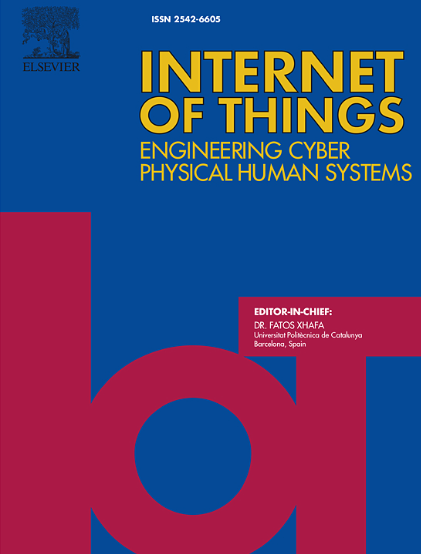Enhancing physical security in IIoMT environments
IF 6
3区 计算机科学
Q1 COMPUTER SCIENCE, INFORMATION SYSTEMS
引用次数: 0
Abstract
The Industrial Internet of Medical Things (IIoMT) transforms healthcare through interconnected devices enabling real-time monitoring, diagnostics, and treatment. However, these devices often lack robust physical security, making them vulnerable to tampering, theft, and unauthorized access. This paper introduces SecureGuard-IIoMT, an innovative adaptive physical security framework designed to mitigate such vulnerabilities across diverse deployment environments. SecureGuard-IIoMT comprises three integrated components enhancing device security. The first, Adaptive Sensor-Based Intrusion Detection (ASID), utilizes vibration, proximity, and pressure sensors combined with lightweight machine learning models to detect unauthorized physical interactions in real-time. ASID maintains detection accuracy across varied conditions by dynamically adjusting its thresholds. The second component, Dynamic Tamper Evident Enclosure (DTE), is a self-healing smart enclosure equipped with a tamper detection circuit. Upon tampering detection, DTE triggers alerts, initiates self-healing to ensure continuous device operation, and logs detailed incident reports for further analysis. The third component, Blockchain-Powered Access Control System (BPACS), leverages blockchain technology to maintain decentralized, secure, and immutable access logs. Only authorized physical access requests are approved and recorded, preventing unauthorized interactions. Extensive simulations and real-world tests demonstrate that SecureGuard-IIoMT achieves an 85 % reduction in tampering risks and a 92 % decrease in unauthorized access attempts. Its lightweight, modular design ensures compatibility with various IIoMT devices without compromising performance or cost-effectiveness. SecureGuard-IIoMT effectively bridges critical security gaps in IIoMT device hardening, providing scalable solutions essential for securing healthcare infrastructures. Future work will focus on integrating quantum-resistant encryption into BPACS and employing advanced tamper-evident materials for enhanced security. Future work will focus on integrating quantum-resistant encryption into BPACS and employing advanced tamper-evident materials for enhanced security. The key contributions of this study include the design of an adaptive multi-sensor intrusion detection module (ASID), a tamper-evident self-healing enclosure (DTE), and a decentralized blockchain-based access control system (BPACS). Collectively, these components achieve an 85 % reduction in tampering risks and a 92 % decrease in unauthorized access attempts while maintaining lightweight and scalable deployment.
加强IIoMT环境中的物理安全
工业医疗物联网(IIoMT)通过互联设备实现实时监控、诊断和治疗,从而改变医疗保健行业。然而,这些设备通常缺乏强大的物理安全性,使它们容易受到篡改、盗窃和未经授权的访问。本文介绍了SecureGuard-IIoMT,这是一种创新的自适应物理安全框架,旨在减轻不同部署环境中的此类漏洞。SecureGuard-IIoMT包括三个集成组件,增强设备的安全性。第一种是基于自适应传感器的入侵检测(ASID),它利用振动、接近和压力传感器与轻量级机器学习模型相结合,实时检测未经授权的物理交互。ASID通过动态调整其阈值来保持不同条件下的检测准确性。第二个组件,动态防篡改外壳(DTE),是一个配备了篡改检测电路的自修复智能外壳。在检测到篡改后,DTE触发警报,启动自我修复以确保设备持续运行,并记录详细的事件报告以供进一步分析。第三个组件是区块链驱动的访问控制系统(BPACS),它利用区块链技术来维护分散、安全和不可变的访问日志。只有授权的物理访问请求被批准和记录,防止未经授权的交互。大量的模拟和实际测试表明,SecureGuard-IIoMT可以将篡改风险降低85%,将未经授权的访问尝试减少92%。其轻量级模块化设计确保了与各种IIoMT设备的兼容性,而不会影响性能或成本效益。SecureGuard-IIoMT有效地弥补了IIoMT设备加固中的关键安全漏洞,为保护医疗保健基础设施提供了必不可少的可扩展解决方案。未来的工作将集中在将抗量子加密集成到BPACS中,并采用先进的防篡改材料来增强安全性。未来的工作将集中在将抗量子加密集成到BPACS中,并采用先进的防篡改材料来增强安全性。本研究的主要贡献包括设计了自适应多传感器入侵检测模块(ASID)、防篡改自修复外壳(DTE)和基于区块链的去中心化访问控制系统(BPACS)。总的来说,这些组件在保持轻量级和可扩展部署的同时,将篡改风险降低了85%,将未经授权的访问尝试降低了92%。
本文章由计算机程序翻译,如有差异,请以英文原文为准。
求助全文
约1分钟内获得全文
求助全文
来源期刊

Internet of Things
Multiple-
CiteScore
3.60
自引率
5.10%
发文量
115
审稿时长
37 days
期刊介绍:
Internet of Things; Engineering Cyber Physical Human Systems is a comprehensive journal encouraging cross collaboration between researchers, engineers and practitioners in the field of IoT & Cyber Physical Human Systems. The journal offers a unique platform to exchange scientific information on the entire breadth of technology, science, and societal applications of the IoT.
The journal will place a high priority on timely publication, and provide a home for high quality.
Furthermore, IOT is interested in publishing topical Special Issues on any aspect of IOT.
 求助内容:
求助内容: 应助结果提醒方式:
应助结果提醒方式:


